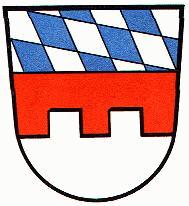Landshut (kreis): Difference between revisions
Knorrepoes (talk | contribs) m (Text replace - "|width="15%"|50 px|right |} " to "|width="15%"|50 px|right |}<seo title="Wappen, Gemeindewappen" /> ") |
Knorrepoes (talk | contribs) m (Text replace - "[[Literature" to "{{media}} [[Literature") |
||
| Line 17: | Line 17: | ||
The lower part of the arms shows the arms of the Counts of Preysing, who were one of the most important noble families in the district. | The lower part of the arms shows the arms of the Counts of Preysing, who were one of the most important noble families in the district. | ||
{{media}} | |||
[[Literature]] : Stadler, K. : Deutsche Wappen - Bundesrepublik Deutschland. Angelsachsen Verlag, 1964-1971, 8 volumes. | [[Literature]] : Stadler, K. : Deutsche Wappen - Bundesrepublik Deutschland. Angelsachsen Verlag, 1964-1971, 8 volumes. | ||
Revision as of 00:28, 9 July 2014
| Heraldry of the World Civic heraldry of Germany - Deutsche Wappen (Gemeindewappen/Kreiswappen) |
LANDSHUT (LA)
State : Bayern
Additions : 1972 Rottenburg an der Laaber, Vilsbiburg
Origin/meaning
The arms were granted on August 25, 1960 and confirmed on May 23, 1973.
The upper part shows the arms of Bayern. These are identical to the arms of the Wittelsbach family, who took the arms from the Counts of Bogen in 1242. Here the diamonds indicate three historical items : Ludmilla von Bogen founded a monastery in Seligenthal in the district. Secondly, the city of Landshut was founded by the Wittelsbach family and a branch of the family named themselves after Landshut. Finally the diamonds indicate the fact that the district is still part of Bayern.
The lower part of the arms shows the arms of the Counts of Preysing, who were one of the most important noble families in the district.
Contact and Support
Partners:
Your logo here ?
Contact us
© since 1995, Heraldry of the World, Ralf Hartemink 
Index of the site
Literature : Stadler, K. : Deutsche Wappen - Bundesrepublik Deutschland. Angelsachsen Verlag, 1964-1971, 8 volumes.











